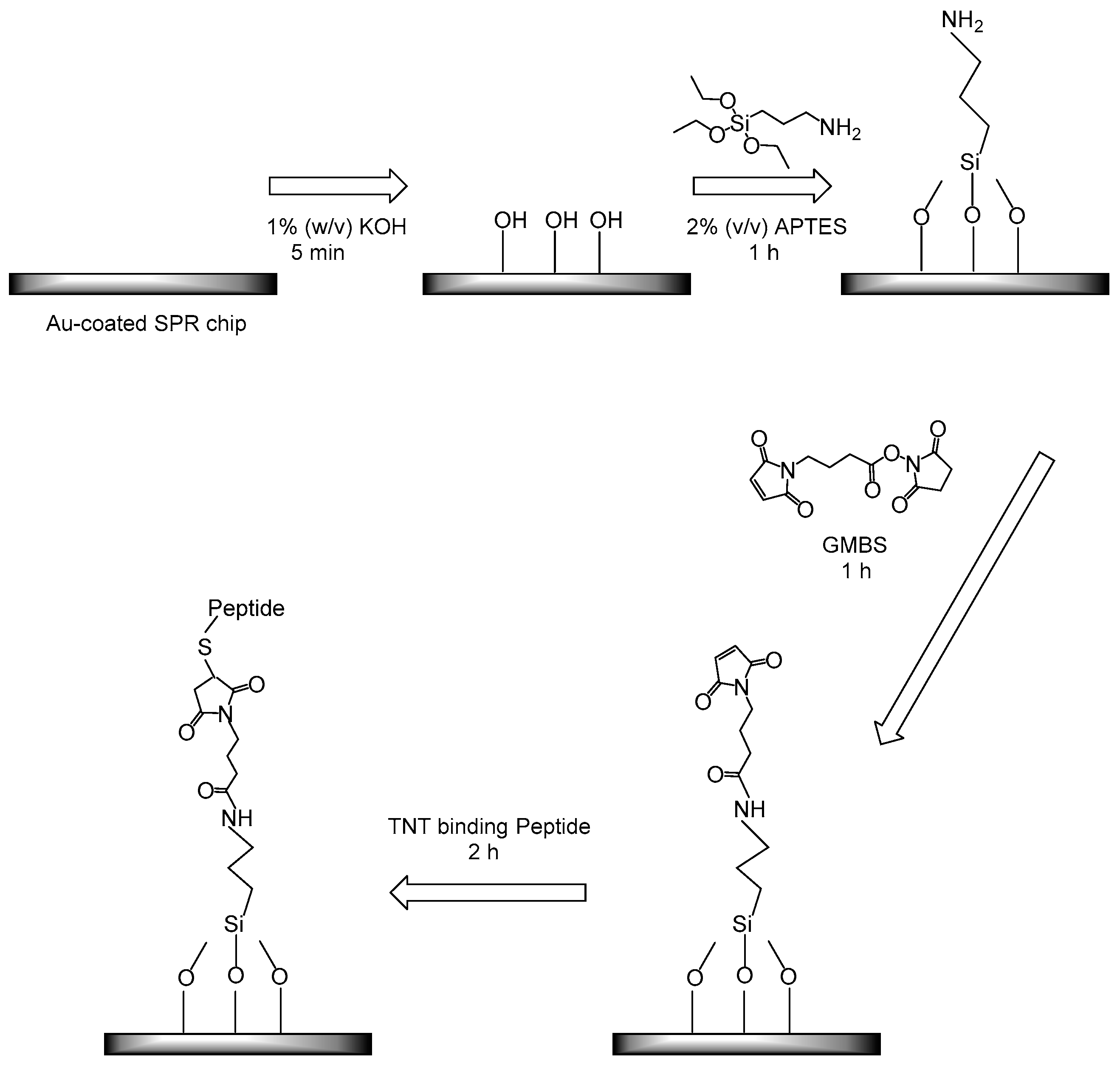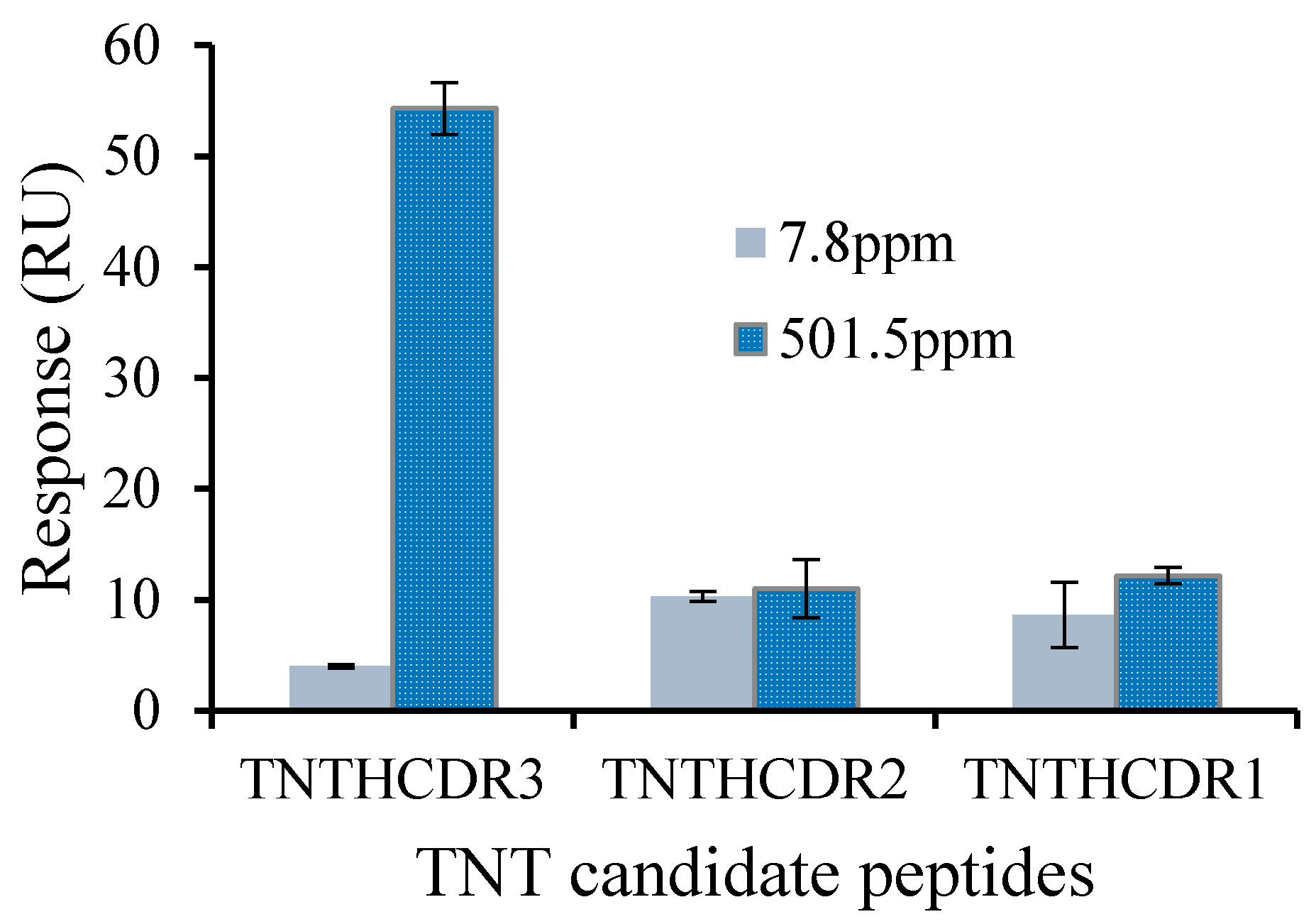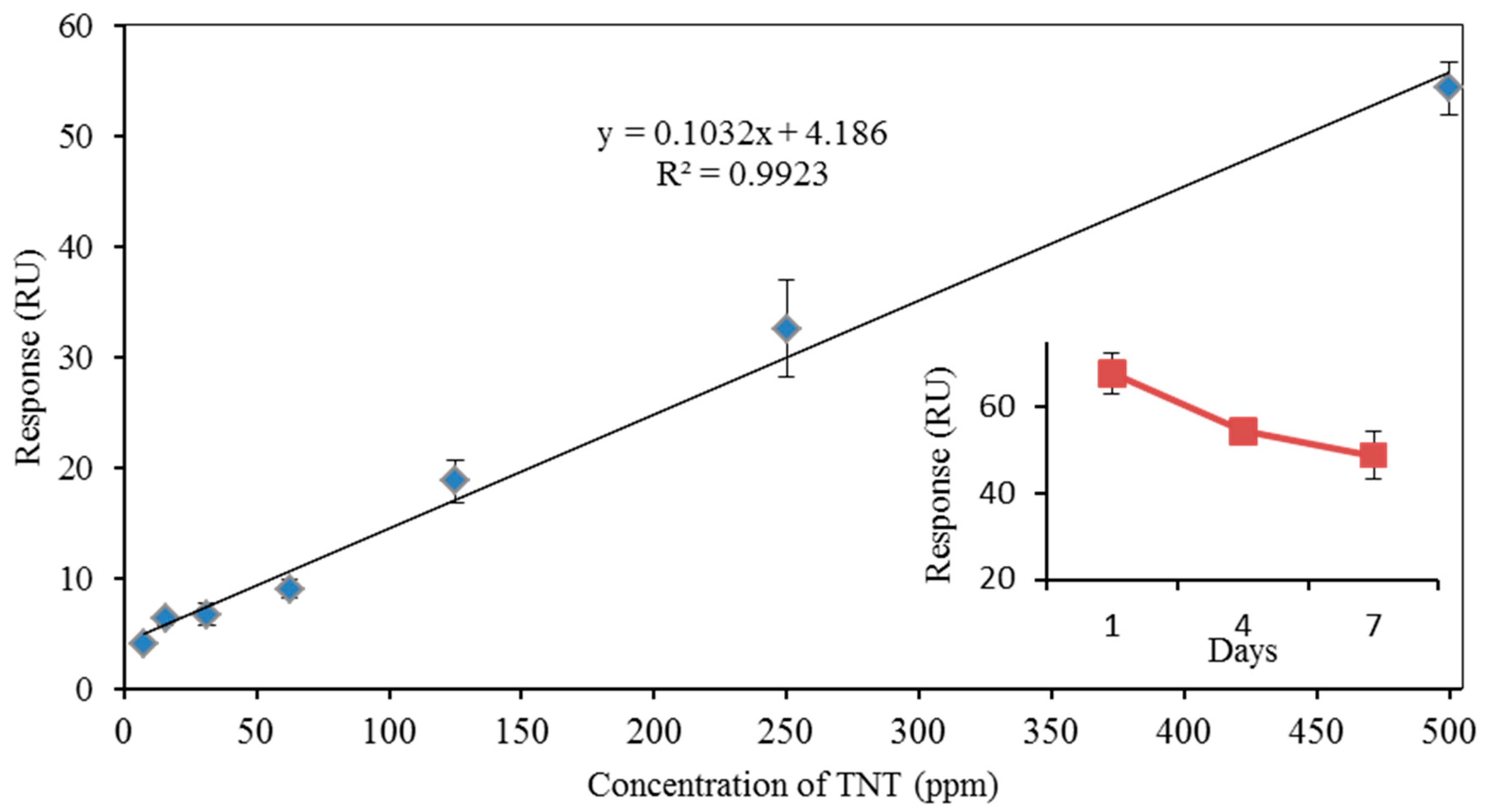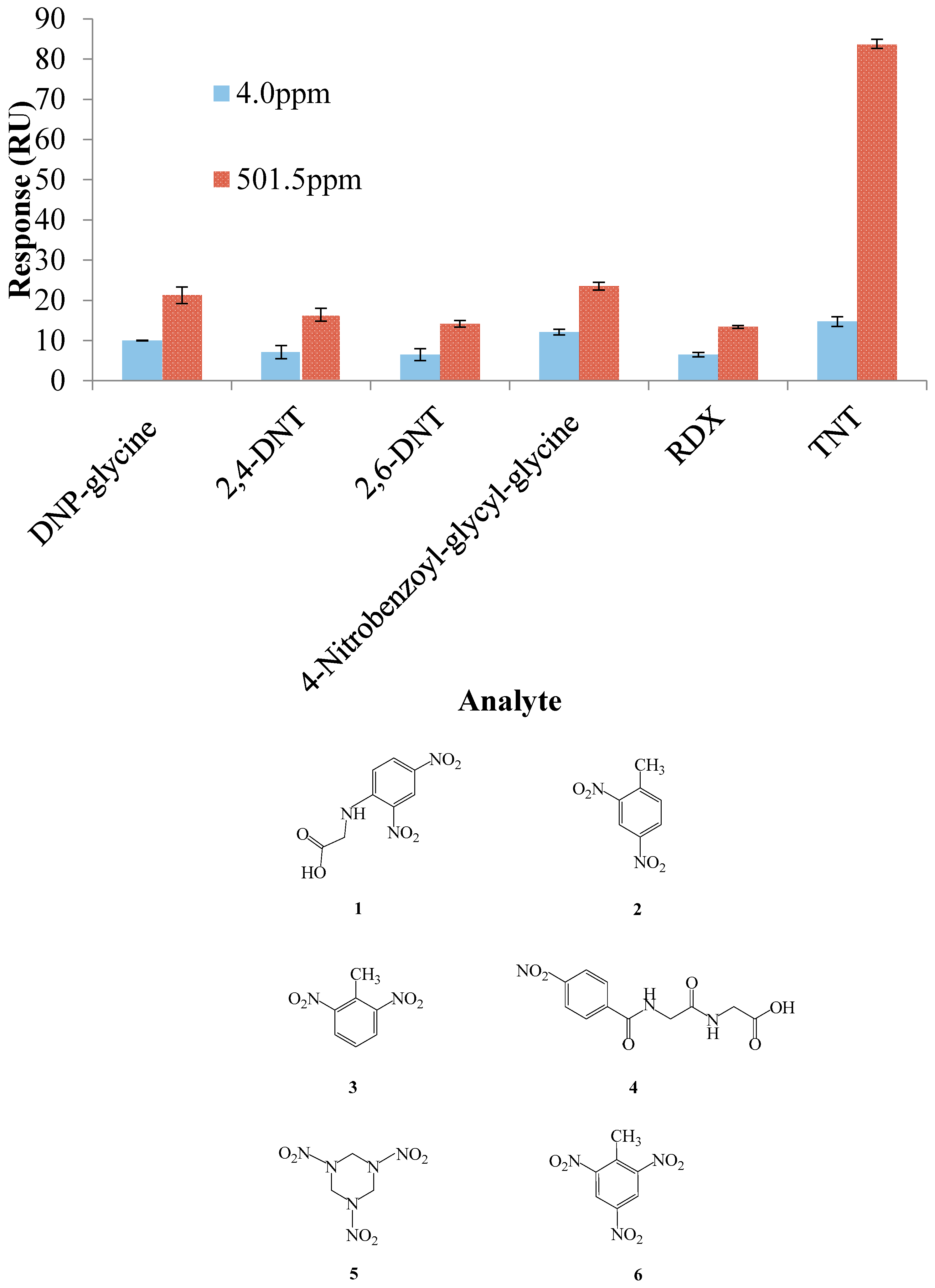Rational Design of Peptide-Functionalized Surface Plasmon Resonance Sensor for Specific Detection of TNT Explosive
Abstract
:1. Introduction
2. Materials and Methods
2.1. Materials and Reagents
2.2. Rational Design of TNT Binding Peptide from Anti-TNT Antibody
2.3. Instrumentation
2.4. Fabrication Procedure of Sensor Chip Surface
3. Results and Discussion
Screening of TNT-Binding Peptides among HCDR Using Maleimide-Based Sensor
4. Conclusions
Acknowledgments
Author Contributions
Conflicts of Interest
References
- Pushkarsky, M.B.; Dunayevskiy, I.G.; Prasanna, M.; Tsekoun, A.G.; Go, R.; Patel, C.K. High-sensitivity detection of TNT. Proc. Natl. Acad. Sci. USA 2006, 103, 19630–19634. [Google Scholar] [CrossRef] [PubMed]
- Kim, T.H.; Lee, B.Y.; Jaworski, J.; Yokoyama, K.; Chung, W.J.; Wang, E.; Lee, S.W. Selective and sensitive TNT sensors using biomimetic polydiacetylene-coated CNT-FETs. ACS Nano 2011, 5, 2824–2830. [Google Scholar] [CrossRef] [PubMed]
- Kuang, Z.; Kim, S.N.; Crookes-Goodson, W.J.; Farmer, B.L.; Naik, R.R. Biomimetic chemosensor: Designing peptide recognition elements for surface functionalization of carbon nanotube field effect transistors. ACS Nano 2010, 4, 452–458. [Google Scholar] [CrossRef] [PubMed]
- Bentes, E.; Gomes, H.L.; Stallinga, P.; Moura, L. Detection of explosive vapors using organic thin-film transistors. Proc. IEEE Sens. 2004, 2, 766–769. [Google Scholar]
- Cerruti, M.; Jaworski, J.; Raorane, D.; Zueger, C.; Varadarajan, J.; Carraro, C.; Majumdar, A. Polymer-oligopeptide composite coating for selective detection of explosives in water. Anal. Chem. 2009, 81, 4192–4199. [Google Scholar] [CrossRef] [PubMed]
- Wang, J.; Makhaita, M.A.; Biswal, S.L. Sensitive detection of TNT using competition assay on quartz crystal microbalance. J. Biosens. Bioelectron. 2012, 3, 1–7. [Google Scholar] [CrossRef]
- Yang, L.; Ma, L.; Chen, G.; Liu, J.; Tian, Z.Q. Ultrasensitive SERS detection of TNT by imprinting molecular recognition using a new type of stable substrate. Chemistry 2010, 16, 12683–12693. [Google Scholar] [CrossRef] [PubMed]
- Raorane, D.; Lim, S.H.; Majumdar, A. Nanomechanical assay to investigate the selectivity of binding interactions between volatile benzene derivatives. Nano Lett. 2008, 8, 2229–2235. [Google Scholar] [CrossRef] [PubMed]
- Riskin, M.; Ran, T.V.; Willner, I. Imprinted au-nanoparticle composites for the ultrasensitive surface plasmon resonance detection of hexahydro-1,3,5-trinitro-1,3,5-triazine (RDX). Adv. Mater. 2010, 22, 1387–1391. [Google Scholar] [CrossRef] [PubMed]
- Jaworski, J.; Yokoyama, K.; Zueger, C.; Chung, W.J.; Lee, S.W.; Majumdar, A. Polydiacetylene incorporated with peptide receptors for the detection of trinitrotoluene explosives. Langmuir 2011, 27, 3180–3187. [Google Scholar] [CrossRef] [PubMed]
- Jaworski, J.; Raorane, D.; Huh, J.H.; Majumdar, A.; Lee, S.W. Evolutionary screening of biomimetic coatings for selective detection of explosives. Langmuir 2008, 24, 4938–4943. [Google Scholar] [CrossRef] [PubMed]
- Okochi, M.; Muto, M.; Yanai, K.; Tanaka, M.; Onodera, T.; Wang, J.; Ueda, H.; Toko, K. Array-based rational design of short peptide probe derived from an anti-TNT monoclonal antibody. ACS Comb. Sci. 2017. [Google Scholar] [CrossRef] [PubMed]
- Vashist, S.K.; Schneider, E.M.; Luong, J.H.T. Surface plasmon resonance-based immunoassay for human C-reactive protein. Analyst 2015, 140, 4445–4452. [Google Scholar] [CrossRef] [PubMed]
- Vashist, S.K.; Schneider, E.M.; Lam, E.; Hrapovic, S.; Luong, J.H.T. One-step antibody immobilization-based rapid and highly-sensitive sandwich ELISA procedure for potential in vitro diagnostics. Sci Rep. 2014, 4, 4407. [Google Scholar] [CrossRef] [PubMed]
- Vashist, S.K. 3-aminopropyltriethoxysilane-based bioanalytical procedures for potential in vitro diagnostics. J. Basic Appl. Sci. 2014, 10, 469–474. [Google Scholar] [CrossRef]
- Mizuta, Y.; Onodera, T.; Singh, P.; Matsumoto, K.; Miura, N.; Toko, K. Development of an oligo (ethylene glycol)-based SPR immunosensor for TNT detection. Biosens. Bioelectron. 2008, 24, 191–197. [Google Scholar] [CrossRef] [PubMed]
- Onodera, T.; Mizuta, Y.; Horikawa, K.; Singh, P.; Matsumoto, K.; Miura, N.; Toko, K. Displacement immunosensor based on surface plasmon resonance for rapid and highly sensitive detection of 2,4,6-trinitrotoluene. Sens. Mater. 2011, 23, 39–52. [Google Scholar]
- Kobayashi, M.; Sato, M.; Li, Y.; Soh, N.; Nakano, K.; Toko, K.; Imato, T. Flow immunoassay of trinitrophenol based on a surface plasmon resonance sensor using a one-pot immunoreaction with a high molecular weight conjugate. Talanta 2005, 68, 198–206. [Google Scholar] [CrossRef] [PubMed]
- Shankaran, D.R.; Gobi, K.V.; Sakai, T.; Matsumoto, K.; Toko, K.; Miura, N. Surface plasmon resonance immunosensor for highly sensitive detection of 2,4,6-trinitrotoluene. Biosens. Bioelectron. 2005, 20, 1750–1756. [Google Scholar] [CrossRef] [PubMed]
- Dower, S.K.; Gettins, P.; Jackson, R.; Dwek, R.A.; Givol, D. The binding of 2,4,6-trinitrophenyl derivatives to the mouse myeloma immunoglobulin A protein MOPC 315. Biochem. J. 1978, 169, 179–188. [Google Scholar] [CrossRef] [PubMed]
- Zang, F.H.; Gerasopoulos, K.; Fan, X.Z.; Brown, A.D.; Culver, J.N.; Ghodssi, R. An electrochemical sensor for selective TNT sensing based on Tobacco mosaic virus-like particle binding agents. Chem. Commun. 2014, 50, 12977–12980. [Google Scholar] [CrossRef] [PubMed]




© 2017 by the authors. Licensee MDPI, Basel, Switzerland. This article is an open access article distributed under the terms and conditions of the Creative Commons Attribution (CC BY) license (http://creativecommons.org/licenses/by/4.0/).
Share and Cite
Wang, J.; Muto, M.; Yatabe, R.; Onodera, T.; Tanaka, M.; Okochi, M.; Toko, K. Rational Design of Peptide-Functionalized Surface Plasmon Resonance Sensor for Specific Detection of TNT Explosive. Sensors 2017, 17, 2249. https://doi.org/10.3390/s17102249
Wang J, Muto M, Yatabe R, Onodera T, Tanaka M, Okochi M, Toko K. Rational Design of Peptide-Functionalized Surface Plasmon Resonance Sensor for Specific Detection of TNT Explosive. Sensors. 2017; 17(10):2249. https://doi.org/10.3390/s17102249
Chicago/Turabian StyleWang, Jin, Masaki Muto, Rui Yatabe, Takeshi Onodera, Masayoshi Tanaka, Mina Okochi, and Kiyoshi Toko. 2017. "Rational Design of Peptide-Functionalized Surface Plasmon Resonance Sensor for Specific Detection of TNT Explosive" Sensors 17, no. 10: 2249. https://doi.org/10.3390/s17102249
APA StyleWang, J., Muto, M., Yatabe, R., Onodera, T., Tanaka, M., Okochi, M., & Toko, K. (2017). Rational Design of Peptide-Functionalized Surface Plasmon Resonance Sensor for Specific Detection of TNT Explosive. Sensors, 17(10), 2249. https://doi.org/10.3390/s17102249






